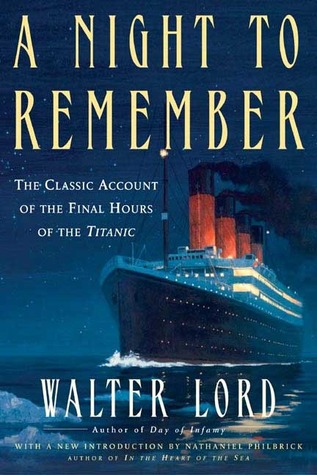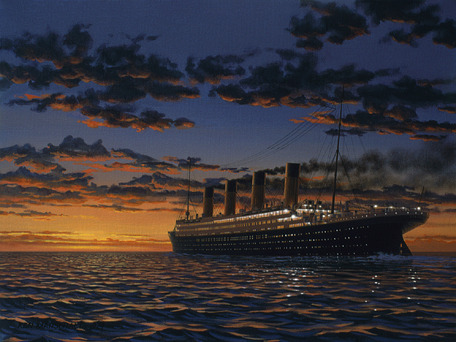There are stories that captivate the world until they dwell more in the ground of legend than in the reality´s. The best example without any doubt is the story of the RMS Titanic, the legendary British transatlantic sunk in 1912 after colliding with an unexpected iceberg on its maiden voyage. About it have been made some films, and a huge amount of books. The one written by Walter Lord is considered the best one about the tragedy: ‘A night to remember’, in Spain it is called ‘La última noche del Titanic’, was published in 1955 and it was sold in large numbers; suddenly the public recovered the interest in a story which was already considered almost fictitious; in fact, three years after its publication, in 1958, it was branded a new film about the Titanic with the same title and starring by Kenneth Moore. The script by Eric Ambler was based in the book by Lord.
Walter Lord, graduate in History from Princeton and in Law from Yale, was an anonymous historian who had already written some other books before, and who wrote some others later, but none had the success of this one. ‘A night to remember’ rescued from oblivion many aspects of the sinking which could lost forever, and this is which makes it a mandatory source for anyone who wants to know more about the last night of the RMS Titanic.

This success is logical, taking into account the intense research work carried out by the writer: he interviewed to many survivors of the tragedy, or to the family members of many others who could not tell their experiences, such as the daughter of captain Smith, or the widow of any illustrious casualty of the Titanic. However, what was new in this book was that, for first time the sinking of the most famous ship in the world was narrated too by its most humble protagonists: the few survivors of the Third Class who could told to Lord the unfair social order aboard the Titanic, and the few possibilities that they had to reach safety into any of the lifeboats of the transatlantic. It was indeed the first opportunity of the poorest passengers aboard to tell the horror of that night.
Since the news that no one could believe were confirmed, the story of the last hours of the Titanic (called an “unsinkable ship” by the White Star Line, its shipping company) became much more than the one of a tragic boat trip: everything about the ship is superlative: the biggest and the most luxurious one in the world, sunk in a stupid maritime accident in its first voyage (and the last one for his captain, who was going to retire after it), with many of the biggest fortunes in the world aboard it, such as the bussinessman John Jacob Astor, the richest passenger in the Titanic, or the Colonel Archibald Butt, militar Assistant of the US Presidents T. Roosevelt and W. H. Taft, in addition to many British landowners, such as the Count and the Countess of Duff-Gordon.
The Titanic was an exponent of the industrial progress of its time: the Belle Époque, a time of unlimited optimism and vanity. So, the unbelievable end of the Titanic assumed for the people of that age a notice of what was going to be the 20th Century; maybe the future was not going to be so quiet and gold as they thought. As Lord himself says in his book: “the sinking was the first notice of the turbulent years to come; before the Titanic, the society was quiet and optimist about the future; after it, a tide of disappointment has covered everything”.
So, the story of the ‘Unsinkable ship’ is an immortal lesson of humility and prudence for the human being: the biggest mobile object ever made by the hand of man destroyed after half a week of operation (the RMS Titanic set sail from Southampton on Wednesday the 10th of April 1912, and sunk the following Monday, April 15). Using again the words of Lord: “since then no one has never believed so blindly in no certainty; the Titanic, as a metaphor, is a turning point in human History”.

Since the first moment too, mystery has surrounded this story: still today, more than a hundred years after the most famous maritime tragedy, it is not clear at all what really happened that icy and dark night. The Titanic encountered with an iceberg at 23.40 of Sunday 14th of April 1912 and sunk definitively at 2:20 of Monday 15th; in that space of time so many things happened, that, as Lord explains, “it would be an ingenuity to pretend to know everything”. Who was a coward? Who died with nobility? It is known that some billionaires died with courage as their social position demanded them (the best example is Benjamin Guggenheim), and it is known too that some others, like the president of the Whiter Star Line, Bruce Ismay, abandoned the ship sneaking into a lifeboat among women and children (in addition, apparently, Ismay had pressed the Captain during the trip to increase the speed of the Titanic).
There are much more doubts: did an anonymous man sneak into a lifeboat disguised as a woman? Were the passengers of the Third Class banned by the crew to access to the deck of the lifeboats, until all the richest passengers were evacuated? Did the crew shoot the passengers to prevent the assault to the last boats? Is it true that the orchestra of the ship played in the last moments, when everything was given up for lost, the funeral anthem “Nearer my God to thee”? How did the Titanic really sink? And how many people died? According to the American official investigation they were 1517; the British official investigation said that 1490, and the investigation of the British Chamber of Commerce claimed that they were 1503 or 1502.

Among all those dead was the Captain Smith. But, what happened to him? The last time he was seen near the bridge, more or less at 2:10; however, in spite of those who say that he committed suicide, nobody knows how he died. The stoker Harry Senior claimed that he saw him helping a child when the water covered the bridge, but his body was never found. There are more enigmatic deaths: the newspapers echoed of at least twelve different versions of the end of the Colonel Butt, all of them heroic.
And, despite many legends have been denied over the years (the boilers exploiting, the women of some boats mutinying to take over the control of them, the different hours in which the iceberg was seen) this story teaches us to be skeptical about any certainty: for seventy-three years it was thought that the biggest legend about the sinking was that which claimed that the Titanic split in two just before its end; so, when the oceanographer Robert Ballard found the most coveted wreck, the 1st of September 1985, the scientific community was really impacted.

Happened as it happened, one thing is very clear: the story of the Titanic will be forever alive in our collective memory, as a modern Icarus flying over our vanity and ambition.

REFERENCES:
-Walter Lord (1955). A night to remember
-Doug McCallie (1997) Titanic ayer y hoy retrieved February 06, 2014 from: http://www.youtube.com/watch?v=nNj8gSWfjIg